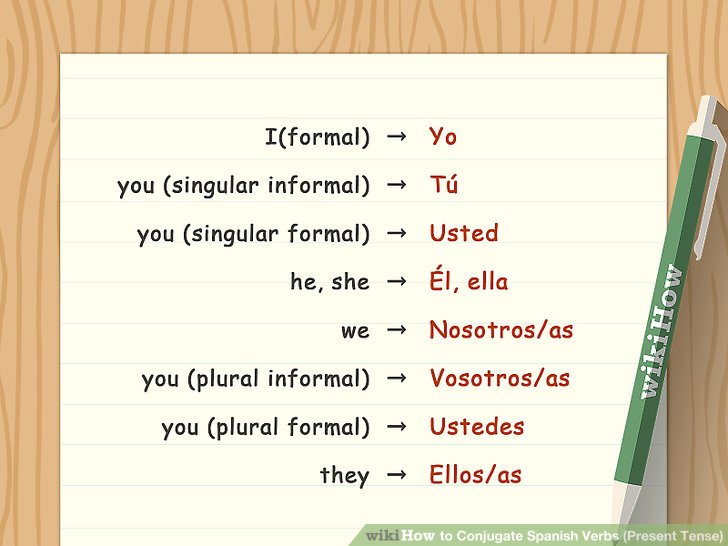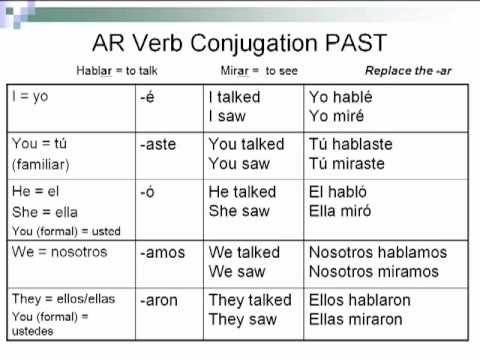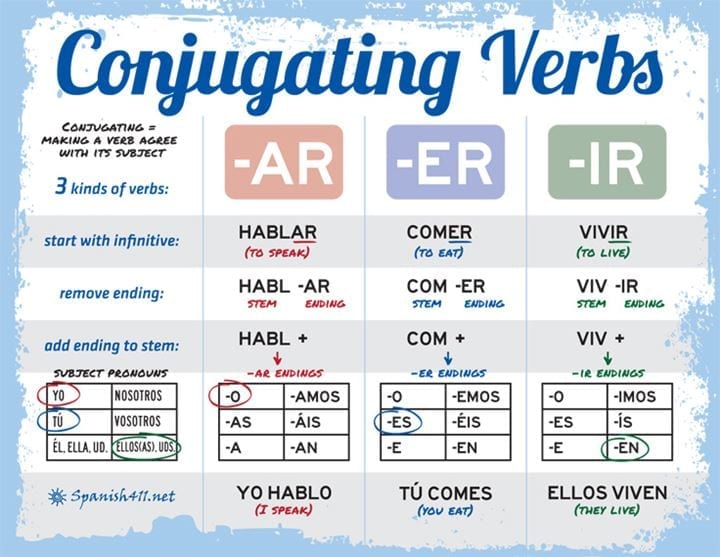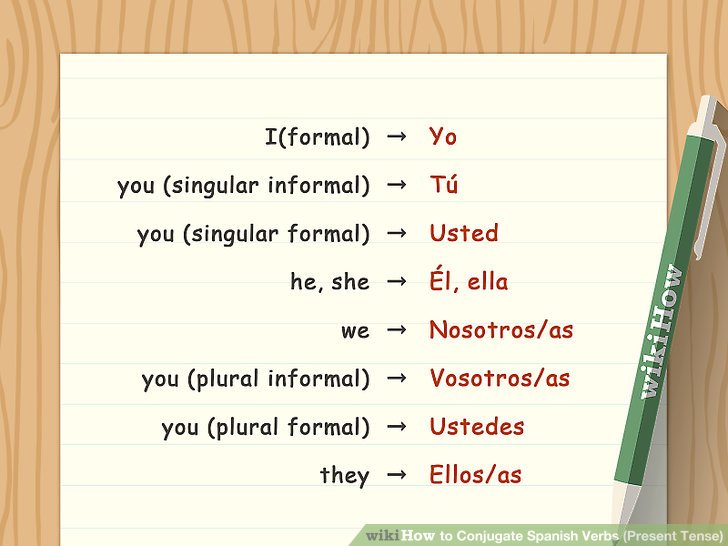In this video presentation you will learn the general rules for conjugating regular Spanish verbs in the:
- Presente (Present) tense
- Indicativo mood
More information on how to conjugate both regular and irregular verbs in this tense, as well as example sentences, may be found below the video.
Note the tense timeline
The ability to properly locate the desired position on the timeline is a crucial skill for proper use of tenses. So pay attention to the timeline in our lessons and visualize it while speaking, listening, writing and reading. After some practice you’ll be able to select the right tense to use much easier.

Video Presentation
How to create and use the Present tense in Spanish
The Presente tense is usually the first tense we learn. It has quite a few irregularities, but because it’s so common and frequently used, it is worth learning to use it well.
Most of the verbs conjugate regularly, and the irregular cases have logical rules, so learning by heart is seldom needed. Note that you can easily remind yourself of the rules every time you visit our conjugator. Just place the mouse cursor over an exception (printed in red color).
There are also spelling corrections, which are usually not considered irregularities. They apply generally to some combinations of letters, so the rules for using them are exactly the same in case of any type of a Spanish word. For example, plural forms of nouns sometimes need a spelling correction. Because they are limited neither to only verbs nor to any particular tense, we describe the spelling corrections in a separate article.
Regular verb conjugation in Spanish Present tense
Presente de Indicativo belongs to the simple tenses group, which means that all of its inflected forms are one word long. There are also compound (compuesto) tenses in Spanish language, where each inflected verb form consists of two words.
The basis for this conjugation is the stem of the verb, so we begin by splitting the infinitive into a stem and an ending. It’s very easy to do. Just remove two letters from the end of the infinitive form and you have the ending — one of -ar, -er or -ir. What’s left is the stem.
For example, if we take the verb tomar and cut off the last two letters, we will get:
- the stem: tom-
- and the ending: -ar
Next, to the stem of the infinitive we add an ending specific to a particular grammatical person to create this person’s form. Continuing our example, if we wanted to create the form for the 1st person singular (yo) of the verb tomar, we would add to the stem tom- the ending -o to get tomo.
The endings used in Presente de Indicativo
The three images below present the endings used in each of the three conjugation groups. Note the shapes and colors of the letters. Find the similarities and differences between the sets. It should help you find patterns and make it easier to remember them. For instance, notice that:
- The 1st person singular (yo) always gets an o ending.
- The 1nd person plural (nosotros/nosotras) always ends with the letters mos.
- The 2nd person singular (tú) and the 2nd person plural (vosotros/vosotras) always end with the letter s.
- The 3rd person plural (ellos/ellas/ustedes) always ends with the letter n.
Spend some time looking for more patterns, then try writing them all down from memory.

These endings are for the -ar verb group. And that’s an example of tomar conjugation:
| singular | plural | ||
|---|---|---|---|
| yo | tomo | nosotros/nosotras | tomamos |
| tú | tomas | vosotros/vosotras | tomáis |
| él/ella/usted | toma | ellos/ellas/ustedes | toman |

This set of endings is used by the -er verb group. The example conjugation for the verb comer would be:
| singular | plural | ||
|---|---|---|---|
| yo | como | nosotros/nosotras | comemos |
| tú | comes | vosotros/vosotras | coméis |
| él/ella/usted | come | ellos/ellas/ustedes | comen |

And the third set of endings is for the -ir verb group. The following example is the conjugation of the verb abrir:
| singular | plural | ||
|---|---|---|---|
| yo | abro | nosotros/nosotras | abrimos |
| tú | abres | vosotros/vosotras | abrís |
| él/ella/usted | abre | ellos/ellas/ustedes | abren |
Irregular verbs in Presente
There are several types of anomalies that affect verb conjugation in Presente de Indicativo. They are presented in subsections below. In this article we focus on the Presente tense, but we also explain how a given irregularity influences forms in other tenses. It will help you minimize the amount of material you need to memorize. That’s because it’s much easier to learn the conjugation through understanding the rules and patterns as they apply to the entire conjugation system, than to learn each tense in separation from others. And it’s enough to understand and remember the irregularities in the Present and Preterite tenses to be able to create the irregular forms in most other tenses!
We use codes like e->i for some of the changes. Using codes, images and colors helps your brain stay interested and focused, so adapt these or come up with your own and make notes using Mind Maps.
e->ie | Verbs changing the last e in the stem to ie
In this group of verbs the last vowel e in the stem is replaced with the letters ie.
It’s convenient to think about this change as happening only in Presente de Indicativo, persons 1st, 2nd, 3rd singular and 3rd plural. It never gets beyond these grammatical persons in the tenses it influences, that is:
- Presente de Subjuntivo
- Imperativo Afirmativo & Negativo
And why does this change influence these three tenses? Simply because their forms are created based on the 3rd person singular of Presente de Indicativo. So just remembering that a given verb is affected by this irregularity in Presente de Indicativo and that the change doesn’t propagate to other persons – you are able to properly create forms of three other tenses! It is true as long as the 1st person singular is not entirely irregular here (which will be covered further on).
That’s the conjugation of pensar for example:
| singular | plural | ||
|---|---|---|---|
| yo | pienso | nosotros/nosotras | pensamos |
| tú | piensas | vosotros/vosotras | pensáis |
| él/ella/usted | piensa | ellos/ellas/ustedes | piensan |
We highly encourage you to open the page with all the conjugation charts for pensar now and find by yourself all the places where the e is changed to ie in Presente de Indicativo and where it is inherited by other tenses.
List of e->ie irregular verbs: acertar, acrecentar, alentar, apacentar, apretar, arrendar, ascender, asentar, aserrar, atender, aterrar, atestar, atravesar, aventar, calentar, cegar, cerner, cerrar, cimentar, comenzar, concertar, condescender, confesar, contender, defender, dentar, desacertar, desalentar, desasosegar, desatender, descender, desconcertar, desenterrar, desgobernar, deshelar, desmembrar, despertar, desplegar, desterrar, discernir, distender, emparentar, empedrar, empezar, encender, encerrar, encomendar, enmendar, ensangrentar, entender, enterrar, entrecerrar, entregar, escarmentar, extender, fregar, gobernar, heder, helar, hender, herrar, incensar, invernar, manifestar, mentar, merendar, negar, nevar, pensar, perder, plegar, quebrar, querer, recalentar, recomendar, recomenzar, regar, remendar, requebrar, reventar, reverter, segar, sembrar, sentar, serrar, subarrendar, temblar, tender, tentar, transcender, trascender, tropezar, verter.
o->ue | Verbs changing the last o in the stem to ue
In this group of verbs the last vowel o in the stem is replaced with the letters ue.
This group follows the exact same rules as e->ie described above. An example verb belonging to this group is mover:
| singular | plural | ||
|---|---|---|---|
| yo | muevo | nosotros/nosotras | movemos |
| tú | mueves | vosotros/vosotras | movéis |
| él/ella/usted | mueve | ellos/ellas/ustedes | mueven |
Again, take a look at the full set of conjugation charts for mover to get a big picture of the influence of this type of change on all the conjugations.
List of o->ue irregular verbs: absolver, acordar, acostar, aforar, almorzar, amoblar, amolar, apostar, aprobar, asolar, atronar, avergonzar, cocer, colar, colgar, comprobar, concordar, conmover, consolar, contar, costar, degollar, demoler, demostrar, denostar, desaprobar, descolgar, descollar, desconsolar, descontar, descornar, desenvolver, desolar, desollar, despoblar, devolver, discordar, disolver, disonar, doler, emporcar, encontrar, engrosar, envolver, escocer, esforzar, forzar, holgar, llover, moler, morder, mostrar, mover, poblar, poder, probar, promover, recocer, recordar, recostar, reforzar, remover, renovar, repoblar, reprobar, resollar, resolver, resonar, retorcer, revolcar, revolver, rodar, rogar, soldar, soler, soltar, soñar, sonar, torcer, tostar, trastocar, trastrocar, trocar, tronar, volar, volcar, volver.
e->i | Verbs changing the last e in the stem to i
In this group of verbs the last vowel e in the stem is replaced with the vowel i.
It’s convenient to think about this change as happening only in:
- persons 1st, 2nd, 3rd singular and 3rd plural of Presente Indicativo — so exactly the same persons as in case of the 2-letter changes (e->ie & o->ue), plus:
- 3rd person singular & plural of Pretérito Perfecto Simple
- Gerundio
Contrary to the e->ie and o->ue changes, this change influences all the grammatical persons of all the Imperative and simple Subjunctive tenses. That’s because their forms are created based on either the 3rd person singular of Presente de Indicativo or the 3rd person plural of Pretérito Perfecto Simple de Indicativo. So just remembering about these basic properties of this irregularity, you are also able to properly create forms of all the imperative and simple subjunctive tenses for a given verb! (As long as the 1st person singular is not entirely irregular).
Below is an example conjugation of the verb pedir:
| singular | plural | ||
|---|---|---|---|
| yo | pido | nosotros/nosotras | pedimos |
| tú | pides | vosotros/vosotras | pedís |
| él/ella/usted | pide | ellos/ellas/ustedes | piden |
As before, we again encourage you to open the page with all the conjugation charts for pedir now and find all the forms where e is changed to i.
List of e->i irregular verbs: agredir, antedecir, bendecir, ceñir, colegir, competir, concebir, constreñir, contradecir, corregir, decir, derretir, desceñir, desleír, despedir, desteñir, desvestir, elegir, embestir, estreñir, expedir, freír, gemir, impedir, investir, maldecir, medir, pedir, predecir, reelegir, regir, reír, remedir, rendir, reñir, repetir, revestir, seguir, servir, sofreír, sonreír, teñir, transgredir, vestir.
Most of these verbs can be recognized by their last few letters:
- -edir
- -etir
- -egir
- -eír
- -eñir
- decir and derived verbs (ending in -decir)
e->ie + e->i | Verbs with a mix of e changes
In this group of verbs, the two models described before are mixed: e->ie & e->i. The Present tense only experiences the e->ie change. For example, the verb sentir conjugates as follows:
| singular | plural | ||
|---|---|---|---|
| yo | siento | nosotros/nosotras | sentimos |
| tú | sientes | vosotros/vosotras | sentís |
| él/ella/usted | siente | ellos/ellas/ustedes | sienten |
But we want the big picture again, so we need to explain the mix here. The other part of this change (e->i) affects directly the Preterite tense. We remember from the previous sections that these changes influence other tenses as well. And the good news is that the knowledge we already have is sufficient to correctly conjugate this group of verbs. Simply think about this mix this way:
- First — apply the e->i model
- Second — overwrite e->i with the e->ie model
To see that in action:
- Open in a separate window all the conjugation charts for sentir.
- Recall that the 1-letter changes influence all the persons of the Imperative mood tenses and the simple Subjunctive tenses as well as the Gerund form. Determine the places where e should change to i (you may use pedir charts for hints, as it has only the e->i changes). Is the e changed to i in all the expected places?
- Now apply the e->ie changes (use pensar charts for hints). Remember that they do not propagate to the first two plural persons. That’s why in places like the 1st person plural (nosotros/nosotras) of Presente de Subjuntivo the forms retain the i – the modification introduced by the initially applied e->i change.
List of e->ie + e->i irregular verbs: adherir, advertir, asentir, conferir, consentir, convertir, desmentir, diferir, digerir, disentir, divertir, herir, hervir, inferir, ingerir, injerir, interferir, invertir, mentir, pervertir, preferir, presentir, proferir, referir, requerir, revertir, sentir, sugerir, transferir, zaherir.
o->ue + o->u | Verbs with a mix of o changes
This irregularity works exactly as the e->ie + e->i described above, just mixes changes affecting the o vowel. There are only two verbs behaving like that: dormir and morir. Analyze the conjugation charts for one of these verbs and map all what was written above for the e vowel to the o vowel.
Verbs with an entirely irregular first person singular of the Present tense
Regardless of the type of change affecting verb forms in Presente, the 1st person singular may also be entirely irregular here. And when that happens, the three derived tenses, which normally use the 3rd person’s form as the basis of their conjugation, use mostly the 1st person’s form instead (if it ends with an -o, otherwise they use an irregular stem). Have a look at all tener conjugation charts to see that in action. Conjugation of this verb in the Present tense looks as follows:
| singular | plural | ||
|---|---|---|---|
| yo | tengo | nosotros/nosotras | tenemos |
| tú | tienes | vosotros/vosotras | tenéis |
| él/ella/usted | tiene | ellos/ellas/ustedes | tienen |
The three tenses mentioned use the teng- stem in this case. And an example of a verb where the 1st person does not end in -o is saber, in which case the three derived tenses use the sep- stem:
| singular | plural | ||
|---|---|---|---|
| yo | sé | nosotros/nosotras | sabemos |
| tú | sabes | vosotros/vosotras | sabéis |
| él/ella/usted | sabe | ellos/ellas/ustedes | saben |
Most common irregular endings in the 1st person singular are:
- -go (tener/tengo)
- -zco (conducir/conduzco)
- -y (dar/doy)
List of verbs with an irregular 1st person form: abastecer, aborrecer, acaecer, acontecer, acrecer, adolecer, adormecer, aducir, agradecer, amanecer, amarillecer, amortecer, anochecer, antedecir, aparecer, apetecer, aridecer, atardecer, bendecir, caber, caer, carecer, compadecer, comparecer, complacer, conducir, conocer, contradecir, convalecer, crecer, dar, decir, decrecer, deducir, desaparecer, desconocer, descrecer, desembravecer, desentorpecer, desentumecer, desfallecer, desfavorecer, desguarnecer, deslucir, desmerecer, desobedecer, desvanecer, embebecer, embellecer, embobecer, embravecer, embrutecer, empequeñecer, emplumecer, empobrecer, enaltecer, enardecer, encallecer, encalvecer, encandecer, encanecer, encarecer, encarnecer, endentecer, endurecer, enflaquecer, enfurecer, engrandecer, enlobreguecer, enloquecer, enlucir, enmohecer, enmudecer, enmugrecer, ennegrecer, ennoblecer, enorgullecer, enrarecer, enriquecer, enrojecer, enronquecer, ensoberbecer, ensombrecer, ensordecer, entallecer, entenebrecer, enternecer, entontecer, entorpecer, entrelucir, entristecer, entumecer, envanecer, envejecer, envilecer, escarnecer, esclarecer, establecer, estar, estremecer, fallecer, favorecer, florecer, fortalecer, guarnecer, hacer, humedecer, inducir, introducir, languidecer, lucir, maldecir, mecer, merecer, nacer, obedecer, ofrecer, oír, oscurecer, padecer, palidecer, parecer, perecer, permanecer, pertenecer, poner, predecir, prevalecer, producir, reaparecer, reconducir, reconocer, recrudecer, reducir, reflorecer, rejuvenecer, relucir, reproducir, resplandecer, restablecer, reverdecer, saber, salir, satisfacer, seducir, tener, traducir, traer, valer, venir, verdecer, yacer.
The list seems long, but the vast majority of these verbs doesn’t have to be memorized, because it’s easy to recognize them. Almost each verb ending in one of:
- -acer
- -ecer
- -ocer
- -ucir
has an irregular 1st person in Presente which ends in -zco. Exceptions to this rule are the verbs: satisfacer, *hacer and *cocer (contrahacer, deshacer, hacer, rehacer, cocer, escocer, recocer). The verbs satisfacer and *hacer use the -go ending. The *cocer verbs don’t have 1st person irregularity, but are in the o->ue group and require c->z spelling correction. After excluding all these verbs, we’re left with a much shorter list to remember: caber, caer, dar, estar, oír, poner, saber, salir, tener, traer, valer, venir, plus: antedecir, bendecir, contradecir, decir, maldecir, predecir — which are simply prefix+decir. In most tenses they all conjugate like decir, just have the prefix added in front of each form.
Verbs with an added letter y
All the verbs ending in -uir belong to the group which in Presente de Indicativo gets an additional letter y between the last vowel of the stem and each ending which starts with one of the strong vowels: a, e or o.
Example verbs: afluir, atribuir, circuir, concluir, confluir, conseguir, constituir, construir, contribuir, delinquir, derruir, desobstruir, destituir, destruir, diluir, disminuir, distinguir, distribuir, erguir, estatuir, excluir, extinguir, fluir, huir, imbuir, incluir, influir, instituir, instruir, intuir, obstruir, ocluir, perseguir, proseguir, prostituir, recluir, reconstituir, reconstruir, rehuir, restituir, retribuir, seguir, sustituir.
Looking at all conjugation charts of any of them, we can notice that changes in this group of verbs happen in the exact same places as in case of the e->i model:
- persons 1st, 2nd, 3rd singular and 3rd plural of Presente de Indicativo
- 3rd person singular & plural of Pretérito Perfecto Simple
- Gerundio
That’s because in the Pretérito Perfecto Simple & Gerundio there is also a spelling correction (i->y). All the simple Subjunctive & Imperative tenses are based on the Present and Preterite forms, so the y propagates to multiple tenses.
All the -oír verbs () have a similar change, but also a differently irregular 1st person singular, so their conjugation is different also in three other, derived tenses.
When do we use the Present tense in Spanish
The Present tense is used in Spanish in several ways:
-
To describe a subject, action, state or event in the present moment
That’s the most basic use of this tense:
La toalla está mojada.The towel is wet.A sentence in the Spanish Present tense often translates best to English Present Progressive, although the Spanish Present Progressive also exists and is in common use:
¿Qué haces ahora?¿Qué estás haciendo ahora?What are you doing now? -
To express what will happen in the nearest future
The situation looks a bit different when we want to express what will happen in the nearest future. In English we again use the Present Progressive tense, but we cannot translate it to the Spanish Present Progressive. The Present tense should be used instead:
I’m leaving in the morning.Salgo por la mañana.NOT: Estoy saliendo por la mañana. -
To state general facts and talk about things which happen often or regularly
Visito a mi abuela dos veces a la semana y siempre le llevo galletas.I visit my grandmother twice a week and I always bring her cookies. -
In conditional statements
Si lo comes todo no podrás caminar más.If you eat it all you won’t be able to walk any more.
Next Steps
- For exercises and examples for practicing conjugation in the Present tense, visit our Exercise section. In order to practice this tense only, go to the Select tenses to include in exercises and conjugation configuration section and leave only the Presente tense checked
- To see conjugation charts for all Spanish tenses, including the Presente, visit the Conjugator and type any Spanish verb into the search box
- To explore other learning materials visit the Study section or use the Search to find articles and step by step conjugation guides for particular verbs
Report a mistake | Give feedback
We strive to provide the highest quality content and we greatly appreciate even the smallest suggestions:

